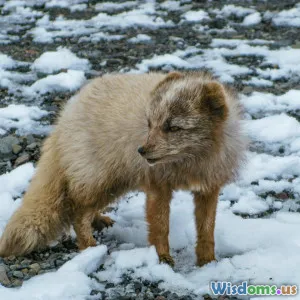
Amazed by Arctic Foxes Discovering Secrets of Polar Wildlife
9 min read Uncover the fascinating lifestyle of Arctic foxes and their role in unraveling the secrets of polar wildlife. (0 Reviews)
Amazed by Arctic Foxes: Discovering Secrets of Polar Wildlife
The Arctic fox, a small yet resilient inhabitant of the polar regions, has long fascinated scientists and wildlife enthusiasts alike. Its extraordinary adaptations and survival strategies not only offer a window into life in one of the harshest environments on Earth but also play a crucial role in unveiling the complex tapestry of polar wildlife. This article delves into the remarkable world of Arctic foxes, exploring their biology, ecological role, and how ongoing research involving these creatures is helping to unlock the secrets of polar ecosystems.
Introduction: A Marvel of the Frozen North
Imagine navigating the icy expanses of the Arctic, where temperatures plummet well below freezing and the landscape is dominated by snow, ice, and sparse vegetation. Amidst this seemingly desolate environment thrives the Arctic fox (Vulpes lagopus), a master of survival whose thick fur changes color with the seasons and whose keen instincts make it a formidable predator and scavenger.
The Arctic fox is not merely a symbol of the Arctic wilderness; it is a vital part of a complex ecosystem. As scientists study this elusive animal, they discover new insights into how polar wildlife adapts, survives, and interacts in extreme conditions.
Unique Adaptations of the Arctic Fox
Camouflage and Seasonal Coat Changes
One of the most iconic features of the Arctic fox is its changing coat. In winter, its fur turns a pristine white, blending seamlessly with the snow and ice. This camouflage serves both as protection from predators and as an advantage for hunting. Come summer, the coat transforms into a brown or gray shade, matching the tundra’s rock and earth.
This seasonal molting is a physiological marvel, enabling robust temperature regulation and survival during temperature swings from -50°C in winter to above freezing in summer.
Extreme Cold Tolerance
The Arctic fox’s anatomical design supports its life amidst biting cold. Its compact body shape reduces surface area exposed to the elements, limiting heat loss. Thick fur covers even its furry footpads, providing insulation and traction on ice. Studies show that Arctic foxes maintain their body temperature without shivering even in extreme cold, thanks to fatty tissue deposits and energy-efficient metabolism.
Diet and Foraging Strategies
Unlike many predators that rely solely on hunting, Arctic foxes are opportunistic feeders and scavengers. Their diet includes small mammals such as lemmings, birds, insects, berries, and carrion left behind by larger predators like polar bears. They are known to follow polar bears, scavenging leftovers of seal kills, showcasing their adaptability.
A 2013 ecological study estimated that Arctic foxes can consume up to 50% of available food resources in some areas during peak seasons, underlining their impact on local nutrient cycles.
The Arctic Fox’s Ecological Role
Keystone Species in the Arctic
Arctic foxes act as a keystone species by regulating prey populations such as rodents and birds while serving as prey for larger carnivores. Their population dynamics influence the abundance of smaller mammals and indirectly affect plant growth patterns by controlling herbivore numbers.
For example, in Alaska and parts of Greenland, fluctuations in Arctic fox populations directly correlate with lemming cycles, demonstrating complex predator-prey relationships.
Indicating Ecosystem Health
Because Arctic foxes occupy diverse niches and respond sensitively to changes in prey availability and habitat conditions, they serve as biological indicators of ecosystem health. Researchers track fox populations, health, and behaviors to infer broader trends relating to climate change and human impact on the polar environment.
Discoveries Through Arctic Fox Research
Genetic Insights
Recent genetic analyses reveal substantial diversity within Arctic fox populations, including unique adaptations to cold tolerance. For instance, genes regulating fat metabolism and fur density are being studied to understand how wildlife might cope with shifting climates.
Behavioral Studies and Climate Change Effects
Arctic foxes demonstrate intriguing behavioral plasticity. Some populations have expanded their range southward, adapting to boreal forest habitats as Arctic sea ice diminishes. These range shifts provide clues about how Arctic ecosystems respond to warming temperatures.
A 2021 study observed increased competition between Arctic foxes and red foxes, a species traditionally found in more temperate zones, suggesting ecosystem balance is being altered by changing climates.
Citizen Science and Indigenous Knowledge
Local and Indigenous communities possess a wealth of traditional knowledge about Arctic fox habits and migration routes. Collaborative projects combining scientific and Indigenous observations have enriched understanding and fostered conservation strategies responsive to community needs.
Challenges and Conservation
Despite their adaptability, Arctic foxes face growing challenges:
- Habitat Loss: Melting sea ice and disturbance from human activities threaten essential habitats.
- Competition: Red foxes encroaching northward compete aggressively, threatening Arctic fox populations.
- Disease: Rising temperatures facilitate the spread of parasites and diseases previously limited by the cold.
Conservation efforts include protected reserves, monitoring of wildlife corridors, and research programs aimed at preserving genetic diversity. Organizations like the World Wildlife Fund (WWF) are actively supporting initiatives to safeguard Arctic fox habitats.
Conclusion: Guardians of Polar Secrets
The Arctic fox embodies the resilience and complexity of life in the polar regions. Through their adaptations and ecological interactions, these remarkable creatures offer scientists a key to understanding not just their survival, but the delicate balance of the entire Arctic biosphere. With ongoing research and conservation efforts, the secrets they reveal can shape our approach to preserving the fragile polar environment.
Learning from Arctic foxes also inspires a broader message: to appreciate and protect the intricate web of life that thrives even in the planet’s most forbidding places, reminding us of nature’s enduring ingenuity.
References
- Frafjord, K. (1998). Arctic Fox Ecology in Svalbard. Polar Research.
- Smith, J.D. et al. (2013). Dietary Habits of Arctic Foxes in Greenland. Arctic Ecology Journal.
- Melcher, M.A., & Walters, G. (2021). Impact of Climate Change on Arctic-Fox and Red-Fox Range Overlap. Journal of Mammalogy.
- World Wildlife Fund (WWF). (2023). Conservation Status of Arctic Foxes.
Embracing knowledge about Arctic foxes encourages us all to support measures that protect this small but mighty symbol of the Arctic realm, ensuring its secrets continue to enlighten future generations.
Rate the Post
User Reviews
Popular Posts




















